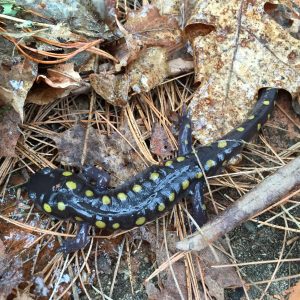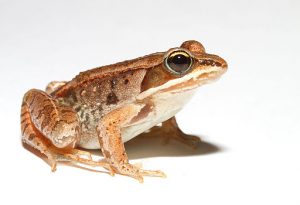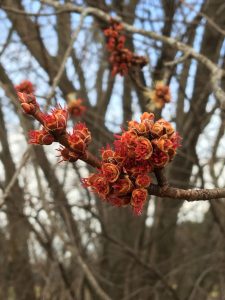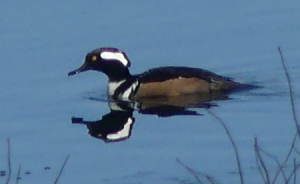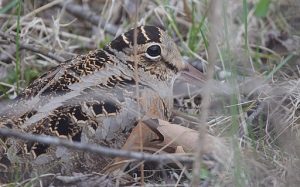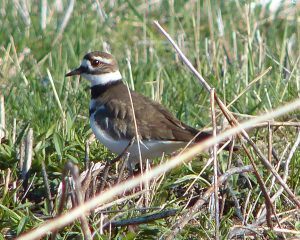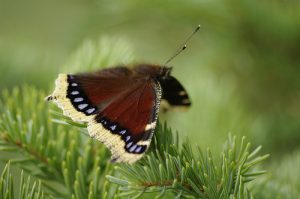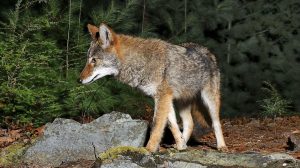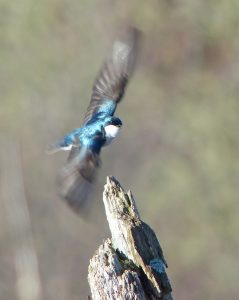Written by Gwyn Loud for the Lincoln Land Conservation Trust. She welcomes your sightings, pictures, and questions at 781 259 8690 or gwynloud555@gmail.com.
Spring will arrive officially on March 19, the vernal equinox, but we have had signs of the new season for several weeks. A warm spell on Mar. 9 and 10 produced temperatures near seventy and brought out the bikers and runners as well as a few mosquitoes. This is tick season too, so be sure to check yourself after being out in woods and fields. Willows are yellow and the small red flowers of red and silver maples give color to the wooded scene. Around our homes crocuses are blooming, daffodils poking up, and forsythia is about to pop. Spring peepers are calling and an observer saw one of our earliest butterflies, the mourning cloak, which has dark maroon wings bordered by yellow edges. It is unusual in that it overwinters as an adult in protected spots.
The annual migration of amphibians such as wood frogs and spotted salamanders to vernal pools to lay eggs has begun. No doubt you have seen the signs on Conant, Silver Hill, and Lexington roads asking drivers to slow down to avoid killing amphibians which are crossing roads, but there are many other places in town where frogs and salamanders may be on the roads in the right conditions. The migration occurs after dark when it is raining and mild, about 38º or higher. Some years the salamanders have to struggle over snowbanks as they move from their wooded hideouts to the vernal ponds, but not this year, thanks to our non-winter. The spotted salamanders do not make any sound but the male wood frogs make quite a racket once they reach the ponds. They sound like quacking ducks, all with the goal of attracting females. This year the wood frog croaking began a bit earlier than usual and it will go on for about a week. The female lays from 500-1500 eggs in clumps of jelly attached to vegetation right on the surface of the shallow pond. In the swamps we are hearing the chorus of tiny male spring peepers, a tree frog less than one inch long which has sticky toe pads to help it clung to branches and twigs a foot or two above the water.
Birds are arriving daily from points south, some to stay and nest here, others just passing through. Canada geese are honking overhead and the red-winged blackbirds arrived as usual the third week of February, greeting us with their distinctive their distinctive “conk-a-ree” songs. We now see flocks of robins on lawns, killdeer in fields, and turkey vultures overhead, all signs of the new season. A single tree swallow has been reported, but soon there will be more, and any day I expect to hear an Eastern phoebe. A few migrating fox sparrows, heading to Canada to breed, have appeared. Another recent arrival is the American woodcock, famous for the male’s aerial mating display. About twenty minutes past sunset, near a wet meadow, listen for a nasal “peent” call, followed by a twittering high overhead, the sound made by the bird’s outer primary feathers. After circling aloft, the woodcock chirps as he plummets down to the ground in the same spot, ready to repeat the dance until it is completely dark. Hopefully a female is watching silently nearby and is eager to mate.
A Trapelo Road resident wrote about witnessing another mating display: “I looked out across the Donaldsons’ fields to the top of Flint’s field where the warm morning sunshine first hits. This morning the sun alighted on a flock of turkeys, including 3-4 toms strutting their stuff with their tail feathers in full fan. They were glowing in the morning sun. The ladies appeared unimpressed. But I was.”
Eastern bluebirds are busy investigating bird boxes, so it is time to clean yours out if you haven’t already done so. At Drumlin Farm house sparrows are building nests. Male American goldfinches, a drab olive like the females all winter, are now showing hints of canary-yellow as they start molting into spring plumage. I have had many reports of red-tailed hawks, some doing aerial courtship displays, and pileated woodpeckers seem to be all over town. Common ravens are becoming more common, living up to their name; maybe they will nest in Lincoln. Other bird sightings of note include a bald eagle, a broad-winged hawk and a belted kingfisher. Wood ducks are back, and ducks such as hooded mergansers, bufflehead, and ring-necked have been seen on ponds, the Cambridge Reservoir, and the Sudbury River.
As for mammals, March is peak mating season for many, and this includes loud barks, yips, and howls from animals such as coyotes, fishers, and foxes. Chipmunks have come up from their winter burrows, the males emerging before the females. Naturalist Mary Holland writes, “When females appear, they soon come into estrus, which lasts for roughly a week. However, they are only receptive to males for about a seven-hour period during this week. Outside of these seven hours, females will aggressively repel any advances. When males sense that their timing is right, they indicate their interest and intention by waving their tail up and down. This only occurs during the mating season – at all other times chipmunks only wave their tail horizontally back and forth!” I am watching my chipmunks’ tails carefully!
Insects will not be very noticeable until warmer weather arrives, but readers may like to know that the monarch butterflies have started northward from their wintering sites in Mexico, leaving earlier than usual due to a heat wave there. This generation will lay eggs in northern Mexico and the southern USA, then die. The eggs will go through the stages of metamorphosis and the resulting adults will continue northward, laying eggs enroute. We should see them in our gardens in late May. To follow the progress of the monarchs’ amazing journey, go to the Journey North site at https://maps.journeynorth.org/map/?year=2020&map=monarch-adult-first.
In this time of worry and disrupted lives due to the coronavirus pandemic, I hope you can find peace and comfort in the rhythms and beauty of nature around us.
© Gwyn Loud


